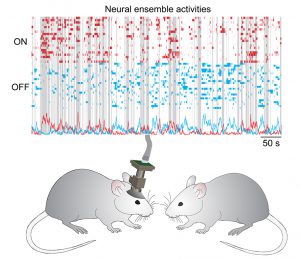Hot Off the Press – October 10, 2018.
 Using miniature fluorescence microscopes (miniScope) via an implanted optical microprobe, Liang and Zhang et. al. were able to record the calcium activity from hundreds of nerve cells in medial prefrontal cortex (mPFC) when the mice freely engaged in social exploration. They track the activity of the same nerve cells for days to weeks and found that “Yin and Yang” nerve cells in the brain dynamically code social exploration. They further showed that systemic administration of the psychedelic drug phencyclidine (PCP, street name Angel Dust) elicited deficits in social exploration, which was associated with reorganized and dysfunctional “Yin and Yang” nerve cells coding social exploration. Their approach could be applied to other mouse models of schizophrenia and autism spectrum disorders, paving the way for future studies of elucidating pathogenic mechanisms for social behavior deficits in these psychiatric disorders.
Using miniature fluorescence microscopes (miniScope) via an implanted optical microprobe, Liang and Zhang et. al. were able to record the calcium activity from hundreds of nerve cells in medial prefrontal cortex (mPFC) when the mice freely engaged in social exploration. They track the activity of the same nerve cells for days to weeks and found that “Yin and Yang” nerve cells in the brain dynamically code social exploration. They further showed that systemic administration of the psychedelic drug phencyclidine (PCP, street name Angel Dust) elicited deficits in social exploration, which was associated with reorganized and dysfunctional “Yin and Yang” nerve cells coding social exploration. Their approach could be applied to other mouse models of schizophrenia and autism spectrum disorders, paving the way for future studies of elucidating pathogenic mechanisms for social behavior deficits in these psychiatric disorders.
Publication Information
Distinct and Dynamic ON and OFF Neural Ensembles in the Prefrontal Cortex Code Social Exploration. Journal Article
In: Neuron, 2018, ISSN: 1097-4199 (Electronic); 0896-6273 (Linking).
